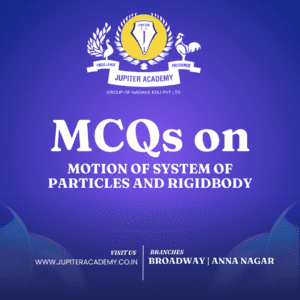NEET 2025: OMR Sheet Filling Tips to Avoid Mistakes Preparing...
Read MoreNEET MCQS ON MOTION OF SYSTEM OF PARTICLES AND RIGIDBODY

A rigid body is defined as the body that has particles which are at a fixed distance from each other and remains constant. For any regular body, the centre of mass lies at the geometrical centre. Also, the turning motion in the rigid body is produced by the net torque.
The motion of systems of particles and rigid body has concepts such as the centre of mass, torque, angular momentum, conservation of angular momentum, the radius of gyration, and theorems related to perpendicular and parallel axes.
Certainly! Below are some multiple-choice questions (MCQs) on the topic of “Motion of System of Particles and Rigid Body” for NEET (National Eligibility cum Entrance Test) preparation:
1. Which of the following quantities remains constant for a system of particles in the absence of any external force?
a) Linear momentum
b) Angular momentum
c) Kinetic energy
d) Total mechanical energy
2. Two masses m1 and m2 are connected by a rigid rod of length L. The moment of inertia of this system about an axis passing through the center of mass and perpendicular to the rod is:
a) (m1 + m2)L^2
b) (m1m2 / (m1 + m2))L^2
c) (m1m2 / (m1 – m2))L^2
d) (m1m2 / (m1 + 2m2))L^2
3. When a body rotates about a fixed axis, the particles located farther from the axis:
a) Have the same angular speed as particles closer to the axis.
b) Have higher angular speed than particles closer to the axis.
c) Have lower angular speed than particles closer to the axis.
d) Have zero angular speed.
4. Which of the following statements about conservation of angular momentum is true?
a) Angular momentum is conserved only in elastic collisions.
b) Angular momentum is always conserved, irrespective of the type of collision.
c) Angular momentum is conserved only when there are no external torques acting on the system.
d) Angular momentum is not conserved in any physical system.
5. The moment of inertia of a solid sphere of mass M and radius R about an axis passing through its center is:
a) (2/5) MR^2
b) (2/3) MR^2
c) (3/5) MR^2
d) (3/2) MR^2
6. A system of particles is initially at rest. If no external force acts on the system, which of the following quantities will be conserved?
a) Linear momentum
b) Angular momentum
c) Kinetic energy
d) Total mechanical energy
7. The radius of gyration of a body about a given axis is doubled. What happens to the moment of inertia of the body about that axis?
a) It becomes half.
b) It doubles.
c) It becomes four times.
d) It remains the same.
8. The center of mass of a system of particles:
a) Always lies inside one of the particles.
b) Always lies outside the system of particles.
c) Always lies on the axis of rotation.
d) Moves in a straight line at constant speed.
9. The angular momentum of a system of particles remains constant if:
a) External forces act on the system.
b) The particles collide with each other.
c) The net external torque acting on the system is zero.
d) The system is not rotating.
10. The moment of inertia of a body depends on:
a) Mass of the body only.
b) Shape and size of the body only.
c) Mass and shape of the body, but not its size.
d) Mass, shape, and size of the body.
Answers:
1. b) Angular momentum
2. b) (m1m2 / (m1 + m2))L^2
3. b) Have higher angular speed than particles closer to the axis.
4. c) Angular momentum is conserved only when there are no external torques acting on the system.
5. a) (2/5) MR^2
6. b) Angular momentum
7. c) It becomes four times.
8. d) Moves in a straight line at constant speed.
9. c) The net external torque acting on the system is zero.
10. d) Mass, shape, and size of the body.
Good luck with your NEET preparation!
JEE MCQS ON MOTION OF SYSTEM OF PARTICLES AND RIGIDBODY
Certainly! Here are some multiple-choice questions (MCQs) on the topic of “Motion of System of Particles and Rigid Body” for JEE (Joint Entrance Examination) preparation:
1. Two particles of masses m1 and m2 are moving in a plane with velocities v1 and v2, respectively. What is the position vector of the center of mass of the system?
a) (m1v1 + m2v2) / (m1 + m2)
b) (m1v1 – m2v2) / (m1 + m2)
c) (m1v1 + m2v2) / (m1 – m2)
d) (m2v1 + m1v2) / (m1 + m2)
2. The moment of inertia of a disc of mass M and radius R about an axis perpendicular to its plane and passing through its center is:
a) MR^2
b) (1/2) MR^2
c) (1/4) MR^2
d) (2/3) MR^2
3. A system of particles is initially at rest. If no external force acts on the system, which of the following quantities will be conserved?
a) Linear momentum
b) Angular momentum
c) Kinetic energy
d) Total mechanical energy
4. The total linear momentum of an isolated system of particles is conserved:
a) Only when the particles collide elastically.
b) Only when the particles collide inelastically.
c) Always, irrespective of the type of collision.
d) Only when the net external force acting on the system is zero.
5. The angular momentum of a system of particles remains constant if:
a) External forces act on the system.
b) The particles collide with each other.
c) The net external torque acting on the system is zero.
d) The system is not rotating.
6. A solid sphere and a hollow sphere of the same mass and radius start from rest at the top of an inclined plane. Which one will reach the bottom first?
a) Solid sphere
b) Hollow sphere
c) Both will reach simultaneously
d) It depends on their masses.
7. The radius of gyration of a body about a given axis is doubled. What happens to the moment of inertia of the body about that axis?
a) It becomes half.
b) It doubles.
c) It becomes four times.
d) It remains the same.
8. The moment of inertia of a body depends on:
a) Mass of the body only.
b) Shape and size of the body only.
c) Mass and shape of the body, but not its size.
d) Mass, shape, and size of the body.
9. The rotational analog of Newton’s second law of motion is:
a) ΣF = ma
b) Στ = Iα
c) F = ma
d) τ = Iα
10. A uniform rod of length L and mass M is rotated about an axis passing through one of its ends and perpendicular to the rod. What is the moment of inertia of the rod about this axis?
a) (1/3) ML^2
b) (1/2) ML^2
c) ML^2
d) (2/3) ML^2
Answers:
1. a) (m1v1 + m2v2) / (m1 + m2)
2. b) (1/2) MR^2
3. b) Angular momentum
4. d) Only when the net external force acting on the system is zero.
5. c) The net external torque acting on the system is zero.
6. b) Hollow sphere
7. c) It becomes four times.
8. d) Mass, shape, and size of the body.
9. b) Στ = Iα
10. d) (2/3) ML^2
Good luck with your JEE preparation!
TN Medical 2024 Counseling: Extension of Round 2 for MBBS & BDS
TN Medical 2024 Counseling: Extension of Round 2 for MBBS...
Read MoreTENTATIVE ROUND-II COUNSELLING SCHEDULE FOR ADMISSION TO MBBS/BDS
Registration Starts from 11-09-2024 10:00 A.M to 13-09-2024 05:00 P.M....
Read MoreNEET MCQS ON MOTION OF SYSTEM OF PARTICLES AND RIGIDBODY NEET MCQS ON MOTION OF SYSTEM OF PARTICLES AND RIGIDBODY NEET MCQS ON MOTION OF SYSTEM OF PARTICLES AND RIGIDBODY NEET MCQS ON MOTION OF SYSTEM OF PARTICLES AND RIGIDBODY NEET MCQS ON MOTION OF SYSTEM OF PARTICLES AND RIGIDBODY NEET MCQS ON MOTION OF SYSTEM OF PARTICLES AND RIGIDBODY NEET MCQS ON MOTION OF SYSTEM OF PARTICLES AND RIGIDBODY NEET MCQS ON MOTION OF SYSTEM OF PARTICLES AND RIGIDBODY NEET MCQS ON MOTION OF SYSTEM OF PARTICLES AND RIGIDBODY NEET MCQS ON MOTION OF SYSTEM OF PARTICLES AND RIGIDBODY
JEE MCQS ON MOTION OF SYSTEM OF PARTICLES AND RIGIDBODY
JEE MCQS ON MOTION OF SYSTEM OF PARTICLES AND RIGIDBODY






